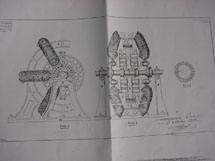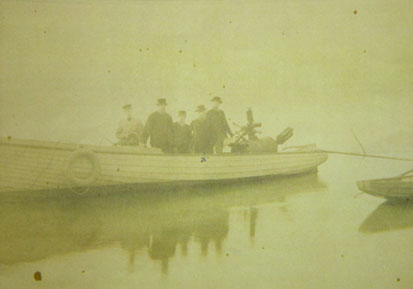|
Désiré Thomas Piot (b.1835-1836 France)
A late nineteenth century French engineer / inventor and the origins of the Vapour Pulse Jet |
|||
|
|
|||
|
|
|
||
|
Whilst living in London Désirée Thomas Piot applied for some 12 UK. patents between 1881-1897 six of which were published. Most of his patents concerned early electric traction motors, dynamos and batteries. These patents could well have related to the development of the first electric underground trains and electric power generators. London’s first electrified underground opened in Dec.1890 between Kingway-Stockwell ( Now part of the Northern Line) on which he worked. Only his last two patents involved pulse jets and where issued in 1891 (No. 20081) and 1897 (No. 26823).
|
|||
|
|
|||
|
|
|
||
|
Several toy manufacturers in Europe and the USA produced a model boat powered by a Piot type propulsion system until 1924. When and American C. J. Mc.Hugh obtained a US patent (No.1,598.934) that modified the propulsion system by adding a vibrating membrane to the flash boiler to give the previously silent pulsing jet the metallic sound of a real marine steam engine.. The 'Pop Pop' was born. The vapour pulse jet boat or 'Pop Pop' has inspired and baffled children and parents alike for a century. Voyaging around the world to fire the imaginations of several generations . Playing with a Piot pulse-jet boat almost certainly inspired a generation of future engineers at the turn of the 19th century to take the idea and develop other forms of pulse jet.
|
|||
|
Piot’s pulse jet pre-dates the more familiar family of air /fuel pulse jets and combines the vapour technology of its time with that of the 1944 flying pulse jet that powered the V1. Managing to encapture the technology of its epoch and project it into the future. A type of hybrid technology ‘Time Machine’ unique in its simplicity and ability to project the steam age into the modern space age.
|
|||
| From China to Brazil you are likely to find one of these cheerful little boats popping around a suitable puddle or basin powered by burning anything that comes to hand from dry leaves and small twigs to wicks dipped in oil or wax. In contrast to today’s modern micro–chip age, toys its stunning simplicity , low cost and scientific educational value come as a refreshing change. | |||
|
|
|||
|
His wife , Victoire Landelle Piot (b.1839-42 France) was a ‘Court dressmaker’ to Queen Victoria and had premises in a quarter of London between Regents Street and Regents Park that today is still used by the fashion houses of high quality couture. Her business possibly helping to subsidise her husband’s inventions. Desire and Victoire probably fled France on the out break of the Franco –Prussian war in 1870 finally arriving in London and moving several times before settling in London W1.at N°. 71 Bolsover Street. No71 Bolsover Street is a 4 minutes walk from Regent’s Park where Piot could have tested his first pulse jet boats. Maybe he had some grandchildren to occupy.... |
|||
|
|
|||
|
|
Desire Piot could well have been inspired by a rocket powered boat developed by Just Buisson and Mr.Cuiru. Demonstrations of their jet boat on the river Seine in Paris took place from August to December 1886 for the benefit of the French Ministry of Defense. Note: It is known that during the period from1880 to 1900 Piot travelled between London and Paris to file for the French patent rights for his electric motors and dynamos. |
||
|
|
A vapour pulse jet has two main parts:
You fill the boiler with water through the tube opening. Place in a pond, bathtub or puddle and place some source of heat under the boiler.
Since 1891 these simple toy boats have been produced in there millions in nearly every country in the world. Simple no batteries all you need is water and some means of heating it. The original multi-fuel engine. By burning: a candle, dry grass or small twigs, charcoal, rolled up newspaper tubes....etc. basically whatever falls to hand. |
||
|
Piot boat’s are known to have been originally available from a chemists shop in Regent’s Street and from A.W.Gamages (Holborn).London.1891. These simple vapour pulse jet boats pre date the more familar air/fuel pulse jets that started to be developed in 1906 and ultimately gave use the V1 and 'cruise missile' technology. Study of the thermodynamics of the oscillating vapour pulse jet cycle relates it to the Stirling cycle family. Patented in 1816 by Rev . Robert Stirling.
|
|||
| Some basic theory |
The oscillating mixed fluid flow inside Stirling’s regenerator
specifications of 1840-1842 bares a striking similarity to that of the jet
– tube found in the Piot pulse – jet.. Where the narrow air gap
between the numerous regenerator plate or rod elements (With air gap ag =
0.79 mm. ) significantly improves the regenerator efficiency. This is
similar to the fluid flow found in the jet tubes of a vapour pulse – jet
where the interior tube diameter and annular condensed liquid film
thickness vary with the length and direction of fluid flow. Controlling
the effective velocity of the cord/ stream of vapour at its center.
There is a fine balancing act between the heat input forcing the system and the heat transfer occurring in the jet condenser tubes absorbing energy and preventing vapour from either being lost from the system or degrading the temperature difference between the hot and cold parts of the cycle. Then giving it back or 'regenerating' as the working fluid pulse changes direction. |
||

|
With a heat input source of 20W the vapour pulse jet functions at a frequency of 34 c/s (Hz). Or a lower harmonic frequency. The classic motor is cyclic in output where the jet pulse amplitudes either gradually damp down, stop and restart or fail to restart with consequential Nukiyama 'burnout'. Burnout is avoided by refilling the boiler with a fresh charge of water or removing the heat source to allow the temperature gradient to re-establish between each end of the condenser jet tube. Before reapplying the heat input source, to restart the process. Small diameter tubes are important for the efficiency of the fluid flow system. They encourage the creation of coaxial fluid flow with a vapour core pulsing at the center of a liquid boundary film. Tubes of a larger daimeter encourage the seperation of the vapour and liquid phases. With the vapour passing above the higher density liquid phase which settles at the bottom of the tube cross section. Diagram which illustrates the different vapour flow fields at low and high velocity flow inside circular tubes.Image
|
||
|
Just Buisson and Mr.Cuiru. 1886 Paris With there rocket powered boat. |
Just in case you think that this has little or no effect on your everyday life. Today the ink–jet printer connected to your computer uses a micro ink-jet to fire pulses of coloured liquid at the surface of the paper .to create a character or symbol. Using the same principle as the original vapour pulse jet. So next time you quickly run off a copy of your report from the printer before dashing to take the metro home. Remember that it is Desire Piot in 1890 that helped make it all possible.
Note: Having helped develop the London Underground. It might just be possible that Desire Piot then went back to Paris (1899>1902) to help develop the first Metro and the electrical power supply infer-structure it depended upon. So maybe we all have something to remember him for. But have you ever heard of him before you read this? |
||
|
Development of a solid propergol rocket engine mounted on a rail wagon.1887 Just Buisson and Mr.Cuiru. |
|||

SS Mandela a modern pulse jet model boat from 'Rose Boats' South Africa |
Desire Thomas Piot the man that launched a million toy boats.
Having been inspired in 1886 by the demonstration by Just Buisson and Mr.Cuiru. in Paris of the World's first rocket powered boat. Note: There rocket boat used 2 pressure exhaust pipes to exhaust excess combustion chamber pressure That ran from the pressure cylinder to the stern of the boat below the water line.
|
||
|
|
All rights reserved © by John Gwynn. This is an original research document and should be credited as your source of information. Please refer to myself and Prof. Jean Le Bot. |
||
|
|
|||
|
Nukiyama 'burnout'
Reference Fundamentals of heat and mass transfer. Frank P. Incropera, David de Witt Publisher Wiley Page 591 Fig 10.3 Copy of page Boiling curve showing different phases Image |
|||
|
Rocket boat of Just Buisson and A Cuircu One unexplored cause for the explosion in Dec 1886 could have been that the exhaust valve allowed a oscillating pressure pulse to set up in the exhaust pipe as the valve was opened and closed abruptly. Allowing a cold jet of water to enter the hot combustion chamber. The thermal shock would certainly have destroyed the combustion chamber. Desire used this oscillating pulse to power his toy boat.
|
|||
|
http://www.i-pornic.com/i-pornic.com/news/130/HistoriquePopPop.pdf
|
|||
|
Interesting research relating to boiling of fluids in microgravity. esa project studying the effect of micro gravity on boiling liquids. Studying effect of electrical field on vapour bubble size. What no bubbles? Results of the ARIEL experiment from Foton-M2 mission http://www.esa.int/esaHS/SEM2JH0VRHE_index_0.html
|
|||
|
Like many others Desire Thomas Piot and his wife Victoire Landelle fled France at the outbreak of the Franco-German war of 1870-71. Monet with his friend Pissaro refused to serve in the army of Napoleon III against Germany and moved to London at about the same time. Discovering the works of Turner and meeting Whistler with whom Monet became good friends. Whilst in London Monet painted Impression Sunrise 1872-73 that featured in the first Impressionist exposition of 1874 in Paris.
|
|||






